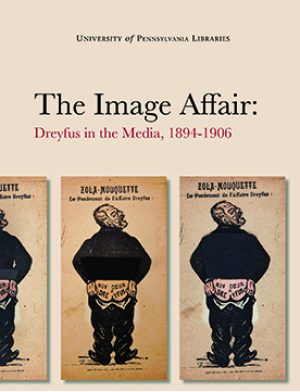
April 25, 2016
For a group of University of Pennsylvania students from André Dombrowski’s fall 2014 curatorial seminar, the excitement of curating an exhibition in the Penn Libraries and creating an accompanying catalog came rushing back when they learned this spring that they had won a national award for their work.
In March, the group received the Association of College and Research Libraries’ Leab Exhibition Award for the catalog for “The Image Affair: Dreyfus in the Media, 1894-1906.”
"We just got an email from the library that we had won an award,” says Dombrowski, an associate professor in the History of Art Department in the School of Arts & Sciences. “I thought, wow, perfect. It was totally out of the blue."
The seminar “Image & Politics: Dreyfus in the Media,” offered five students: two undergraduates, a graduate student and two doctoral students working towards degrees in the history of art, a rare opportunity to help research, curate and select items for the 2015 exhibit and to complete the catalog.
The exhibition, which ran April 13-Aug. 7, 2015 in Van Pelt Library’s Kamin Gallery, examined the 19th-century wrongful conviction for treason of Jewish army captain Alfred Dreyfus as it played out in the French media. Though Dreyfus was eventually exonerated, the political and social scandal was closely watched in France and around the world.
Completing the catalog was the culmination of the semester-long seminar. Working with Andrea Gottschalk, exhibition designer and coordinator of the Kislak Center for Special Collections, Rare Books and Manuscripts, and Dombrowski, the students produced a full color, 133-page, illustrated exhibition catalog, writing descriptions of the objects on display and essays about the scandal.
In preparation for the exhibition, Kislak curators John Pollack and Lynne Farrington aided the students in reviewing and selecting material from the large holdings in the Library archives. The student curators chose illustrated press, photography, newspapers and other publications showing how the print culture of the time transmitted information about the scandal, showcasing viewpoints of Dreyfus’ supporters and detractors.
The objects in the exhibit were derived almost entirely from the Lorraine Beitler Collection of the Dreyfus Affair in Penn Libraries’ Kislak Center.
"It is truly a privilege to have such an intimate relationship with one’s objects of study,” says Hilary Whitham, a doctoral student who worked on the project. “Sometimes that doesn't happen in a seminar if the things that you study are in collections far away or there are just a few of them in existence.”
Some of the Dreyfus materials contained offensive images and language, including hateful, homophobic and anti-Semitic sentiments. Whitham says she and the other students on the project, Lindsay Grant, Gloria Huangpu, Glynnis Stevenson and Jamie Vaught, grappled with whether such items should be included in the exhibit.
One hand-colored 1899 lithograph by V. Lenepveu in the exhibit depicted Dreyfus with a green head, the body of a scaly serpent with clawed feet and a tail. The catalog entry for this image reads, “A Hydra-like serpent visually compounds the textual indictment of his [Dreyfus’] duplicitous character, casting him as a grotesque and unnatural “other” to be slain.”
"We had conversations about our responsibility in presenting racist, homophobic, anti-Semitic and sexist material in a responsible way,” says Whitham. “We wondered, ‘by re-presenting the material, are we reinforcing the message?’”
The team ultimately decided that some of the controversial materials needed to be exhibited to illustrate the politically- and socially-charged climate of the time.
“We felt that looking at those rather hard to talk about topics through this lens would give everyone the ability to find historical precedents for some of our more sensitive and volatile present-day preoccupations,” says Dombrowski.
Whitham says the chance to participate in the project and tackle such issues and decisions has helped to her prepare for a career in curatorial work.
“The most exciting part of the process was when everything was pulled out of storage and we were able to see it all together in one place prior to installation.”
Exhibition Information


